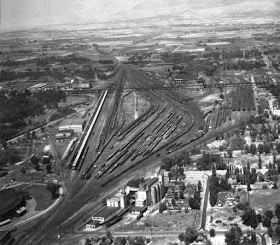-From the book, History of Ogden, Utah in Old Post Cards," by D. Boyd Crawford.
EVER hear the story about the second “Golden Spike”?
Well, it is
just one of those intriguing things that was proposed and “might have been,”
but didn’t actually happen. It is also one of those fascinating historical
footnotes, most of which are usually absent from the history books.
“Last spike
will be a golden one” was a Nov. 21, 1903 headline in the Ogden
Standard-Examiner.
For the
landmark completion of the wooden trestle shortcut across the Great Salt Lake,
the Lucin Cutoff, big plans were proposed early.
The draft
plan was that after driving the Golden Spike, it would be withdrawn and given
to Union Pacific railroad baron E.H. (Edward) Harriman as a souvenir.
In fact, it
was speculated that Harriman himself might wield the sledge himself for the
golden spike, on Thanksgiving Day, noon, on the “Midlake” point of the trestle
itself.
Being
Thanksgiving, it was also suggested that a traditional holiday feast be
prepared at one of the railroad camps along the Lucin Cutoff.
However, six
days later on Nov. 27, at the actual event: “There was no golden spike driven,
or no ceremony of any kind , other than a few congratulations showered upon Mr.
Harriman by many of the large number of railroad men from throughout the United
States,” the Standard reported on that date.
Notwithstanding
the lack of fanfare, the Lucin Cutoff was an engineering marvel for its day. It
shaved 43.77 miles and 1,515 feet of climb off the original route out to
Promontory.
Despite the
completion observance on that Thanksgiving Day, the Lucin Cutoff didn’t
actually open to passenger trains and general traffic until almost 10 months
later, on Sept. 16, 1904.
-The
construction of the Lucin Cutoff was said to feature a safety record superior
to most other railroad projects, yet there were still some accidents.
“Engine
overturns and kills a fireman” was a March 25, 1903 Standard headline. A
portion of the trestle sinking was reported to have caused this accident at
Lakeside, where Robert W. Watson was fatally crushed.
Some other
Utah newspapers reported a “Quagmire without a bottom,” as portions of the
lakebed seemed bottomless.
It was in
that March of 1903 that railroad builders battled what was almost a quicksand
in the Great Salt Lake. At one point in the building process, several hundred
yards of earth were gulped down in the lake and caused a settling of some five
feet.
-Years later
after the Lucin Cutoff had been open, “Severe storm injures Cut-off” was an
April 3, 1910 headline in the Standard. “Eighty-mile gale lashes waves to fury
and damage done,” the subhead stated.
Fortunately,
on that particular day, strangely no trains were scheduled to use the Lucin
Cutoff . Still, the Southern Pacific reported that it had been strengthening
the fill on the trestle for some time, anticipating possible damage such as
this.
-EXTRA INFORMATION: Technically, if a golden spike had been driven on the Lucin Cutoff it would have been the second in Utah, but at least the THIRD golden spike used in the U.S.
The Northern Pacific Railway did use a golden spike on Sept. 8, 1883 to commemorate completion of railroad track in Montana that served many nearby states.
Former U.S. President Ulysses S. Grant drove in that final golden spike to mark the completion of a railroad line from the Great Lakes to the Pacific.
-EXTRA INFORMATION: Technically, if a golden spike had been driven on the Lucin Cutoff it would have been the second in Utah, but at least the THIRD golden spike used in the U.S.
The Northern Pacific Railway did use a golden spike on Sept. 8, 1883 to commemorate completion of railroad track in Montana that served many nearby states.
Former U.S. President Ulysses S. Grant drove in that final golden spike to mark the completion of a railroad line from the Great Lakes to the Pacific.
(-Originally published on-line and in print on Feb. 19-20, 2015 by Lynn Arave in the Ogden Standard-Examiner.)
-NOTE: The author, Lynn Arave, is available to speak to groups, clubs, classes or other organizations about Utah history at no charge. He can be contacted by email at: lynnarave@comcast.net




